Original URL: https://www.theregister.com/2012/06/05/ocz_revodrive_3_x2_240gb_pci_e_card_ssd/
OCZ RevoDrive 3 X2 240GB PCI-E SSD
So long, SATA
Posted in Personal Tech, 5th June 2012 06:00 GMT
Review

One wonders if, after ratifying the SATA 6Gb/s standard, the people at the SATA-IO (Serial ATA International Organization) gave themselves a pat on the back to say job well done, that’s that future-proofed for a while, we can relax now.
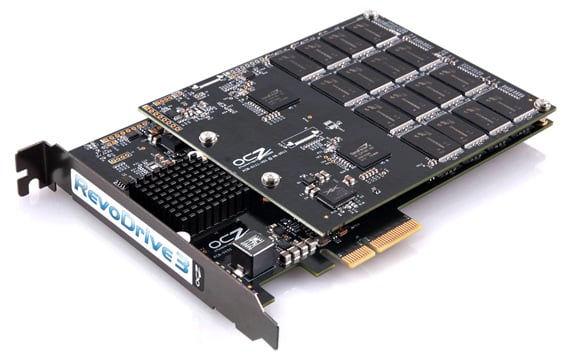
Scorchio: OCZ's RevoDrive 3 X2
After all, you could hardly blame them for that, as the old disk spinning mechanical drives have trouble getting anywhere near the previous SATA 2 (3Gb/s) standards limit so the SATA 3 (6Gb/s) interface isn’t going to be troubled for quite some time, or so they thought.
Yet it appears what the great and the good at SATA-IO didn’t see looming on the horizon – and they certainly weren’t the only ones – was the huge rise in consumer SSDs. Even now, the solid state storage on offer is very close to completely swallowing all the bandwidth available on the SATA 6Gb/s interface – so much for future-proofing.
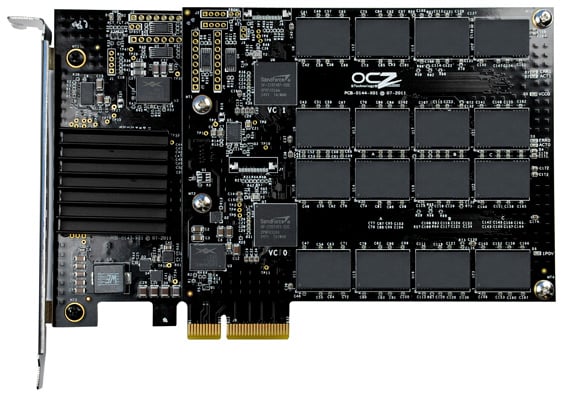
Minus daughtercard: note the two Sandforce controllers
Some companies could see the writing on the wall and sent their R&D teams scuttling away into darkened rooms to come up with other solutions, while we all wait for the ratification of SATA Express. OCZ was one such company and its RevoDrive series of products do away with need for the SATA interface completely, using instead the PCI-E bus of the motherboard. This alternative has the potential to shift huge amounts of data really rapidly and deliver huge transfer rates.
There are two basic versions of the RevoDrive, the standard drive which has everything mounted on a single PCB and the X2 version which has a daughter card added with additional NAND modules and controllers. The RevoDrive 3 series sees the addition of some new technology to the drives in the shape of OCZ’s VCA 2.0 (Virtual Controller Architecture) and SuperScale Storage Accelerator which replace the RAID setup of the original RevoDrives.
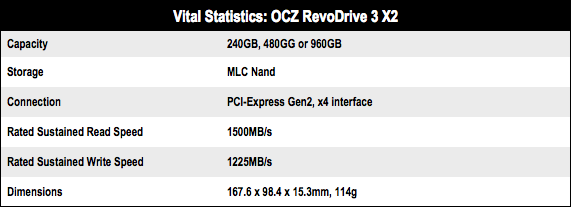
Sandforce sandwich
The problem with original setup was that the RAID controller wouldn’t let commands pass that looked after NCQ and TRIM, amongst others. By using the VCA 2.0 layer, the drive appears as a single device, not four, which allows TRIM, NCQ and SMART support to be implemented.
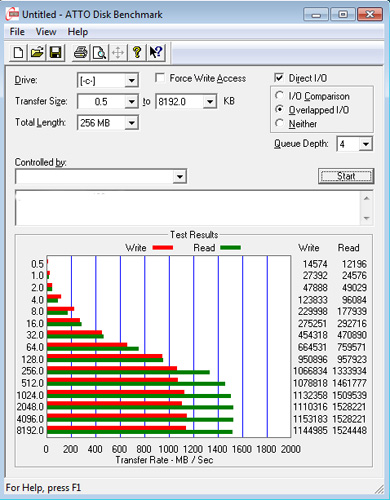
ATTO benchmark results
However, there’s a very big fly in the ointment. Admittedly it won't concern everyone, but here goes... The VCA technology comes from the domain of the enterprise segment, hence it's programmed on SCSI. And yup, you’ve guessed it, Windows StorPort architecture doesn’t currently support the SCSI UNMAP or TRIM functions.
So while the drive supports these operations, Windows 7 cannot generate the commands to make them work. What’s needed is an update to Windows to allow this to happen. But not to worry, the RevoDrive still delivers without these niceties but you do need to be running a Windows 7 machine.
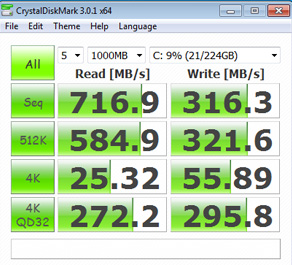
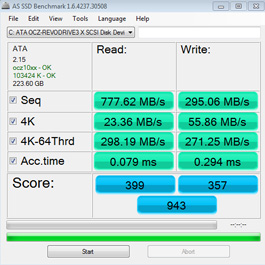
CrystalDiskMark and AS SSD benchmarks
The drive I’m looking at here is the RevoDrive 3 X2 240GB. Imagine two 60GB OCZ Agility 3 drives taken out of their case and mounted on a PCB including both controllers and then have the same again on the daughterboard. You end up with a drive with four Sandforce SF2281 controllers looking after it – yes, four controllers – running in a parallel RAID array, which helps to explain the astonishing quoted maximum read/write figures of 1500MB/s and 1225MB/s, respectively.
The drive fits into any PCI-E x16, x8 or x4 slot although it only runs at x4 electrically. Even so, that is enough theoretically for up to 2GB/s of bandwidth usage which gives you an idea of the potential of using the PCI-E slot.
To instal the drive as a boot device isn’t quite as simple as plugging in a standard drive in. The drivers need to be on a USB stick to allow Windows to access them during installation, but after that it’s plain sailing. Once installed, the boot time for the PC does increase slightly, as there is another status screen in the boot sequence to get past. Once the BIOS had finished loading, the drive took just 10 seconds to get to a Windows desktop.
OCZ’s claimed performance figures hold out pretty well when benchmarked using ATTO, delivering a 1526MB/s read and 1144MB/s write. Needless to say, these are the fastest ATTO results I've seen from any drive I’ve tested by a country mile. However when it comes to handling incompressible data – the Achilles heel of Sandforce controllers – things are a bit different. The AS SSD benchmark produced sequential Read/Write scores of 777MB/s and 295MB/s, respectively.
Iometer Benchmark Comparison
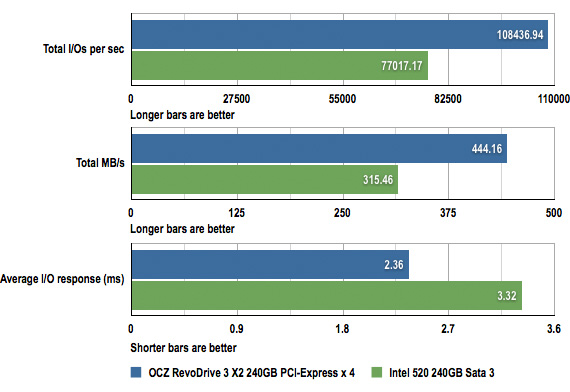
Yet when the drive is put under some serious loading, it really begins to show what it’s made of. For this I used the Iometer benchmark and used a 8GB LBA/sector test to simulate a 100 per cent random write access over 8GB of O/S, which is a heavy and very stressful workload for a desktop environment. It's more akin to what you might encounter in workstation tasks, which is the market segment that the drive is really aimed at.
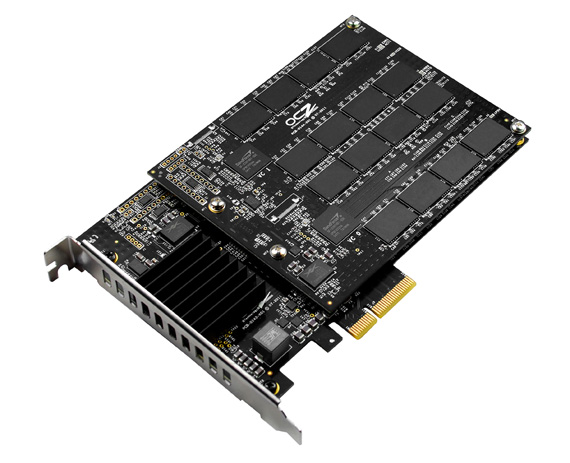
Sata high speed bypass, anyone?
I compared the RevoDrive 3 X2 240GB with the 240GB version of Intel’s latest 520 series Sata 3 drive, which also uses a SandForce controller. As you can see from the Iometer benchmark graph above, the difference between the two drives is certainly striking.
Verdict
The OCZ RevoDrive 3 X2 is a stunningly fast SSD with a price tag to match. If money is no object and you need the fastest storage, around then look no further. ®
More SSD Reviews |
||||
 Intel 520 Intel 520 |
 Samsung 830 Samsung 830 |
 Kingston Kingston
Technology HyperX |
 SanDisk SanDisk
Extreme |
 Crucial M4 Crucial M4 |